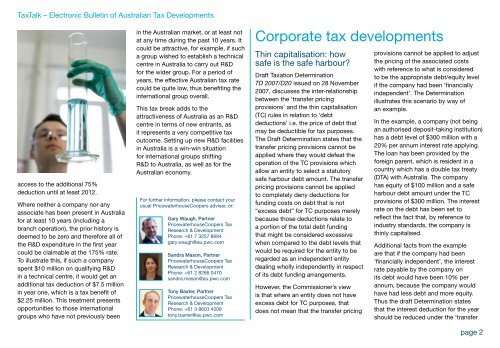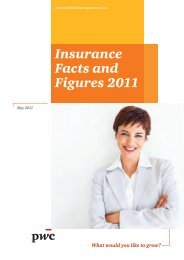Australian R&D tax incentives â another reason for ... - PwC
Australian R&D tax incentives â another reason for ... - PwC
Australian R&D tax incentives â another reason for ... - PwC
You also want an ePaper? Increase the reach of your titles
YUMPU automatically turns print PDFs into web optimized ePapers that Google loves.
TaxTalk – Electronic Bulletin of <strong>Australian</strong> Tax Developments<br />
access to the additional 75%<br />
deduction until at least 2012.<br />
Where neither a company nor any<br />
associate has been present in Australia<br />
<strong>for</strong> at least 10 years (including a<br />
branch operation), the prior history is<br />
deemed to be zero and there<strong>for</strong>e all of<br />
the R&D expenditure in the first year<br />
could be claimable at the 175% rate.<br />
To illustrate this, if such a company<br />
spent $10 million on qualifying R&D<br />
in a technical centre, it would get an<br />
additional <strong>tax</strong> deduction of $7.5 million<br />
in year one, which is a <strong>tax</strong> benefit of<br />
$2.25 million. This treatment presents<br />
opportunities to those international<br />
groups who have not previously been<br />
in the <strong>Australian</strong> market, or at least not<br />
at any time during the past 10 years. It<br />
could be attractive, <strong>for</strong> example, if such<br />
a group wished to establish a technical<br />
centre in Australia to carry out R&D<br />
<strong>for</strong> the wider group. For a period of<br />
years, the effective <strong>Australian</strong> <strong>tax</strong> rate<br />
could be quite low, thus benefiting the<br />
international group overall.<br />
This <strong>tax</strong> break adds to the<br />
attractiveness of Australia as an R&D<br />
centre in terms of new entrants, as<br />
it represents a very competitive <strong>tax</strong><br />
outcome. Setting up new R&D facilities<br />
in Australia is a win-win situation<br />
<strong>for</strong> international groups shifting<br />
R&D to Australia, as well as <strong>for</strong> the<br />
<strong>Australian</strong> economy.<br />
For further in<strong>for</strong>mation, please contact your<br />
usual PricewaterhouseCoopers adviser, or:<br />
Gary Waugh, Partner<br />
PricewaterhouseCoopers Tax<br />
Research & Development<br />
Phone: +61 7 3257 8694<br />
gary.waugh@au.pwc.com<br />
Sandra Mason, Partner<br />
PricewaterhouseCoopers Tax<br />
Research & Development<br />
Phone: +61 2 8266 0470<br />
sandra.mason@au.pwc.com<br />
Tony Baxter, Partner<br />
PricewaterhouseCoopers Tax<br />
Research & Development<br />
Phone: +61 3 8603 4209<br />
tony.baxter@au.pwc.com<br />
Corporate <strong>tax</strong> developments<br />
Thin capitalisation: how<br />
safe is the safe harbour?<br />
Draft Taxation Determination<br />
TD 2007/D20 issued on 28 November<br />
2007, discusses the inter-relationship<br />
between the ‘transfer pricing<br />
provisions’ and the thin capitalisation<br />
(TC) rules in relation to ‘debt<br />
deductions’ i.e. the price of debt that<br />
may be deductible <strong>for</strong> <strong>tax</strong> purposes.<br />
The Draft Determination states that the<br />
transfer pricing provisions cannot be<br />
applied where they would defeat the<br />
operation of the TC provisions which<br />
allow an entity to select a statutory<br />
safe harbour debt amount. The transfer<br />
pricing provisions cannot be applied<br />
to completely deny deductions <strong>for</strong><br />
funding costs on debt that is not<br />
“excess debt” <strong>for</strong> TC purposes merely<br />
because those deductions relate to<br />
a portion of the total debt funding<br />
that might be considered excessive<br />
when compared to the debt levels that<br />
would be required <strong>for</strong> the entity to be<br />
regarded as an independent entity<br />
dealing wholly independently in respect<br />
of its debt funding arrangements.<br />
However, the Commissioner’s view<br />
is that where an entity does not have<br />
excess debt <strong>for</strong> TC purposes, that<br />
does not mean that the transfer pricing<br />
provisions cannot be applied to adjust<br />
the pricing of the associated costs<br />
with reference to what is considered<br />
to be the appropriate debt/equity level<br />
if the company had been ‘financially<br />
independent’. The Determination<br />
illustrates this scenario by way of<br />
an example.<br />
In the example, a company (not being<br />
an authorised deposit-taking institution)<br />
has a debt level of $300 million with a<br />
20% per annum interest rate applying.<br />
The loan has been provided by the<br />
<strong>for</strong>eign parent, which is resident in a<br />
country which has a double <strong>tax</strong> treaty<br />
(DTA) with Australia. The company<br />
has equity of $100 million and a safe<br />
harbour debt amount under the TC<br />
provisions of $300 million. The interest<br />
rate on the debt has been set to<br />
reflect the fact that, by reference to<br />
industry standards, the company is<br />
thinly capitalised.<br />
Additional facts from the example<br />
are that if the company had been<br />
‘financially independent’, the interest<br />
rate payable by the company on<br />
its debt would have been 10% per<br />
annum, because the company would<br />
have had less debt and more equity.<br />
Thus the draft Determination states<br />
that the interest deduction <strong>for</strong> the year<br />
should be reduced under the ‘transfer<br />
page
















